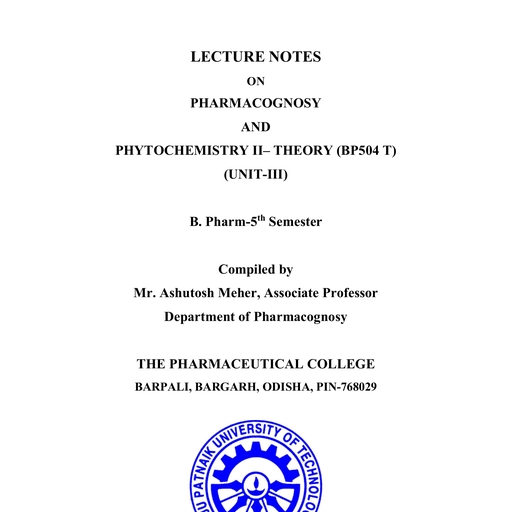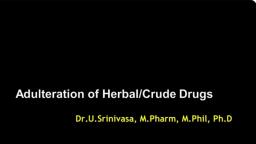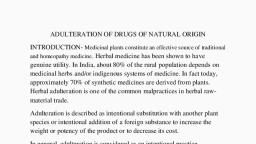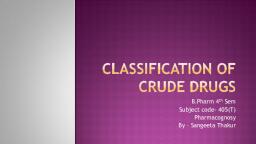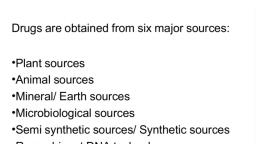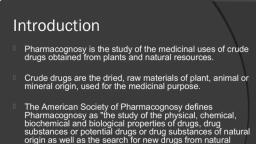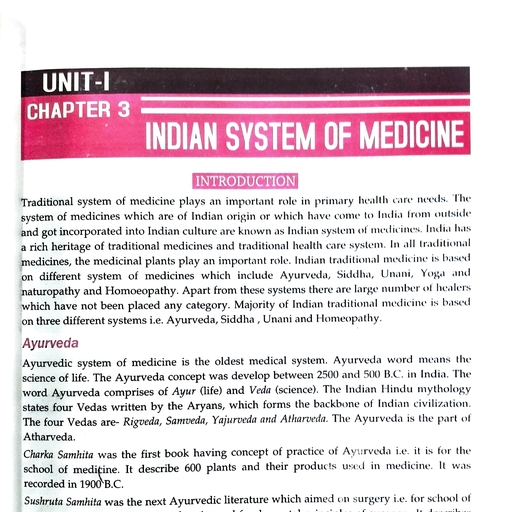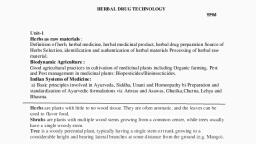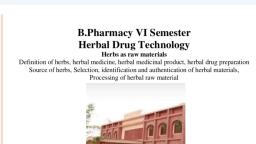Page 1 :
EVALUATION OF CRUDE DRUGS, Evaluation of a drug ensure the identity of a drug and determines the quality and, purity of drugs. The main reasons behind the need for evaluation of crude drugs, are biochemical variation in the drug, effect of treatment and storage of drugs,, and the adulterations and substitutions., , 1)Organoleptic Evaluation, 2)Microscopical Evaluation, 3) Chemical Evaluation, 4)Physical Evaluation, 5)Biological Evaluation, Organoleptic evaluationOrganoleptic evaluation means the study of drugs using organs of senses. It, refers to the methods of analysis like colour, odour, taste, size, shape and, special features, such as touch, texture, etc. Obviously, the initial sight of the, plant or extract is so specific that it tends to identify itself. If this is not enough,, perhaps the plant or extract has a characteristic odour or taste. The study of, form of a crude drug is morphology while description of the form is, morphography., Eg., The fractured surfaces in cinchona, quillaia and cascara barks and quassia wood, are important characteristics., Aromatic odour of umbelliferous fruits and sweet taste of liquorice., The wavy shape of rauwolfia, pungent taste of capsicum and ginger, brown, colour of cinnamon, odour and taste of spice-drugs like, asafoetida, black, pepper, nutmeg, caraway, cumin etc. are important diagnostic organoleptic, characteristics., , Microscopic evaluation This method allows more detailed examination of a drug and it can be used to, identify the organised drugs by their known histological characters. It is mostly, used for qualitative evaluation of organised crude drugs in entire and powdered, forms. Every plant possesses a characteristic tissue feature. Microscope can be, used to confirm the structural details of the drugs from plant origin. For the
Page 2 :
effective results, various reagents or stains can be used to distinguish cellular, structure. A drop of phloroglucinol and concentrated hydrochloric acid give red, stain with lignin. Mucilage is stained pink with rhuthenium red and also, when, treated with corallin soda and few drops of sodium carbonate solution, cellulose, swells and dissolves in cuoxam, while N/50 iodine solution stains starch and, hemicellulose blue., Eg. Lignified trichomes in nux vomica, warty trichomes of senna, wavy, medullary rays of cascara bark, glandular trichomes of mint etc., The powdered cloves do not contain sclereids or calcium oxalate crystals, but, both of them are present in powdered clove stalks., The techniques like microscopic linear measurements, determination of leaf, constants and quantitative microscopic are also used in this evaluation., Linear measurements include size of starch grains, length and width of fibres,, trichomes,etc., Determination of leaf constants include stomatal number, stomatal index, vein, islet, veinlet termination number and palisade ratios. Stomatal number is, average number of stomata per sq. mm of epidermis of the leaf., Stomatal index: it is the percentage which the numbers of stomata form to the, total number of epidermal cells, each stoma being counted as one cell. Stomatal, index can be calculated by using the following formula:, Stomatal index(S.I.)= S/(E+S)×100, Where,, S=Number of stomata per unit area, E= Number of epidermal cells in the same unit area., Timmerman (1927) and Rowson (1943) were amongst the first few to, investigate leaf drugs for stomatal number and stomatal index., Vein-islet number— It is defined as the number of vein islet per sq.mm of the, leaf surface midway between the midrib and the margin. It is a constant for a, given species of the plant and is used as a characteristic for the identification of, the allied species. Levin in 1929 determined vein – islet numbers of several, dicot leaves., Veinlet termination number- It is defined as the number of veinlet termination, per sq. mm of the leaf surface midway between midrib and margin. A, termination is the ultimate free termination of veinlet. Hall and Melville in 1951
Page 3 :
determined veinlet termination number of distinguishing between Indian and, Alexandrian senna., Palisade ratio-It is defined as the average number of palisade cells beneath, each epidermal cell. Unlike vein-islet number for the determination of which an, unbroken portion of the leaf is required, palisade ratio can be determined with, the powdered drug. The technique of palisade ratio determination was, introduced by Zorning and Weiss(1925) in their studies on compositae., Eg. Vein-islet number of Alexandrian senna is 25-29.5, where Indian senna is, 19.5-22.5. Stomatal index of Alexandrian senna is 10-15,whereas that of Indian, senna is 14-20., Quantitative microscopy (Lycopodium spore method)This is an important technique employed in identification of crude drug when, chemical and physical methods are inapplicable. It is inexpensive technique, with official status. Lycopodium spores are very characteristic in shape and, appearense and exceptionally uniform in size(25µm). on an average ,94,000, spores per mg of powdered lycopodium are present., A powdered drug is evaluated by this technique,nif it contains, 1) Well defined particles which may be counted, e.g.starch grains or pollen, grains, 2) Single layered cells or tissue, the area of which may be traced under, suitable magnification and actual area calculated, 3) The objects of uniform thickness, the length of which can be measured, under suitable magnification and actualarea calculated., The percentage purity of an authentic powdered ginger is calculated using, the following equation, N×W×94000×100=%purity, S×M×P, Where,, N= number of characteristic structures(e.g.starch grains) in 26 field, W= weight in mg of lycopodium taken, S=number of lycopodium spores in the same 25 fields, M=weight in mg of the sample, calculated on basis of sample dried at 105 oC, P=2,86,000 in case of ginger starch grains powder.
Page 4 :
Lycopodium spore method can be used for the evaluation of powdered clove,, ginger, cardamom, nutmeg, umbelliferous fruits etc., , Chemical evaluationThe chemical evaluation includes qualitative chemical tests, quantitative, chemical tests, chemical assays and instrumental analysis. The isolation,, purification and identification of active constituents are chemical methods of, evaluation. Qualitative chemical tests include identification tests for various, phytoconstituents like alkaloids, glycosides, tannins,etc., Eg. Copper acetate used in the detection of colophony present as an adulterant., Van Urk’s reagent for ergot, Vitali morins reaction for tropane alkaloids, Iodine for starch, Quantitative chemical tests such as acid value(resins, balsams), saponification, value(balsams), ester value (balsams, volatile oils), acetyl value (volatile oils),, etc. are also useful in evaluation of a drug by means of chemical treatment., Chemical assay include assays for alkaloid, resin, volatile oils, glycoside,, vitamins or other constituent., Eg. Assay of total alkaloid in belladonna herb, the total alkaloid and, nonphenolic alkaloid in ipecacuanha, the alkaloid strychnine in nux vomica, the, resin in jalap and the vitamins in cod -liver oil., The results obtained can conclude the presence of inferior or exhausted drug, and, by proving absence of the assayed constituent., Instrumental analyses are used to analyse the chemical groups of, phytoconstituents using chromatographic spectroscopic methods., , Physical evaluationPhysical standards are to be determined for the drugs, wherever possible. These, are rarely constant for crude drugs, but may help in evaluation, specifically with, reference to moisture content, specific gravity, density, optical rotation,, refractive index, melting point, viscosity, and solubility in different solvents., 1) Moisture content- The moisture content of a drug will be responsible for, decomposition of crude drugs either producing chemical change or, microbial growth. So, the moisture content of a drug should be
Page 5 :
2), , 3), , 4), , 5), , 6), , 7), , determined and controlled. The moisture content is determined by heating, a drug at 105oc in an oven to a constant weight., Eg. The moisture content of digitalis and ergot should not be more than, 5%W/W, respectively., solubilityDrug specific behaviour towards solvents are taken into consideration., Eg. Solubility of colophony of colophony in light petroleum, the, solubility of balsam of Peru in solution of chloral hydrate, optical rotationAnisotropic crystalline solids and samples containing an excess of one, enantiomer of a chiral molecule can rotate the orientation of planepolarized light. Such substances are said to be optically active, and this, property is known as optical rotation., Eg. Eucalyptus oil (0oc to +10oc), honey (+3oc to -15oc), Refractive indexIt is defined as the property of a material that changes the speed of light,, computed as the ratio of the speed of light in a vacuum to the speed of, light through the material. when light travels at an angle between two, different materials, their refractive indices determine the angle of, transmission refraction of the light beam. In general,the refractive index, varies based on the frequency of the light as well; thus, different colours, of light travel at different speeds. High intensities can also change the, refractive index. This could be used as a parameter in evaluating the, herbal drugs., Eg castor oil 1.4758-1.527, Specific gravityIt is also known as relative density. The ratio of the mass of a solid or, liquid to the mass of an equal volume of distilled water at 4 oc(39oF) or of, a gas to an equal volume of air or hydrogen under prescribed conditions, of temperature and pressure., Eg. Specific gravity of drugs are cottonseed oil 0.88-0.93, coconut oil, 0.925, castor oil o.95,etc., ViscosityViscosity of a liquid is constant at a given temperature and is an index of, its composition., Eg.pyroxylin kinematic viscosity, 1100-2450 centistokes., Melting pointPlant constituents have very sharp and constant melting points. As far as, crude drugs are concerned, melting point range has been fixed due to the, mixed chemicals.
Page 6 :
Eg. Beeswax 62-65oc,wool fat 34-44oc, 8) Ultraviolet lightCertain drugs fluoresce when the cut surface or the powder is exposed to, ultraviolet radiation, and it is useful in the identification of those drugs., Eg. Some pieces of rhapontic, Indian and Chinese rhubarb are very, difficult to distinguish, and it is very difficult in powdered form, but, examination in ultraviolet light gives such marked differences in, fluorescence that the varieties can be easily distinguished from each, other., 9) Ash valueThe determination of ash is useful for detecting low grade products,, exhausted drugs, and excess of sandy or earthy matter. Different types of, ash values are used in detection of crude drugs like, total ash, acidinsoluble ash, water- soluble ash and sulphated ash., Total ash is useful in detecting the crude drugs that are mixed with, various mineral substances like sand, soil, calcium oxalate, chalk powder, or other drugs with different inorganic contents to improve their, appearance, as is done with nutmegs and ginger., Acid insoluble ash means the ash insoluble in dilute hydrochloric acid., The majority of crude drugs contain calcium oxalate, and the quantity of, calcium oxalate varies very frequently., Eg. Rhubarb, total ash range from 8-40%. In this case, the total ash is, useless to detect earthy matter adherent to such a drug. So, acid insoluble, ash would be preferable for rhubarb. The calcium oxide or carbonate,, yielded by the incinerated oxalate, will be soluble in hydrochloric acid, when the ash is treated with hydrochloric acid; the remaining ash is, weighed, which is known as the acid -insoluble ash. By this we can detect, the presence of excessive earthy matter, which is likely to occur with, roots and rhizomes., The water-soluble ash is used to detect the presence of material exhausted, by water. Sulphated ash is done by addition of sulphuric acid in order to, get sulphate salts, and the percentage ash is calculated with reference to, the air -dried drug., 10), Extractive valuesThe extracts obtained by exhausting crude drugs with different solvents, are approximate measures of their chemical constituents. Various, solvents are used according to the type of the constituents to be analysed., Water soluble extractive is used for crude drugs containing water-soluble, constituents like glycosides, tannins, mucilage etc; alcohol- soluble, extractive is used for crude drugs containing tannins, glycosides, resins,
Page 7 :
etc; and ether-soluble extractives are used for drugs containing volatile, constituents and fats., 11), Foreign organic MattersThe parts of the organ or organs other than those parts of drugs, mentioned in the definition and description of the drug are known as, foreign organic matters. They may be insect, moulds, earthy material,, animal excreta, etc., Eg. Garlic should not contain more than 2%, saffron should not contain, more than 2%., , Biological evaluationWhen the estimation of potencyof crude drug or its preparation is done by, means of its effect on living organisms like bacteria, fungal growth or, animal tissue or entire animal, it is known as bioassay. This method is, generally called for, when standardisation is not adequately done by, chemical or physical means and also for conformity of therapeutic, activity of raw material and finished product. In other words, bioassay is, the measure of sample being tested capable of producing biological effect, as that of the standard preparation. Such activity is represented in units, known as international unit (I.U.), The specific biological activity contained in each I.U. of the few drugs is, mentioned as under:, Digitalis- 1IU is contained in 76 mg of standard preparation, VitA- 1 IU is present in 0.344 micrograms of standard preparation, Biological assy methods are mainly of 3 types, Toxic, Symptomatic, Tissue methods, In toxic and symptomatic techniques, the animals are used, whereas in tissue, method, the effect of a drug is observed on isolated organ or tissue. Among the, drugs that are subjected to bioassay are cardiac glycosides, natural pesticides, and antibiotics.

